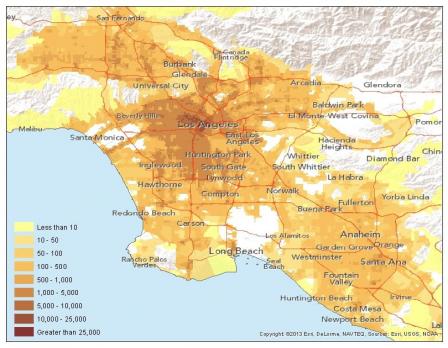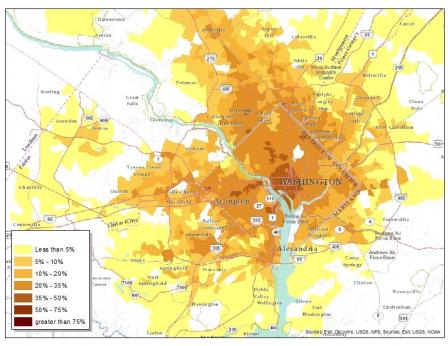Smart Location Mapping
Interactive maps and data for measuring location efficiency and the built environment
You will need Adobe Reader to view some of the files on this page. See EPA’s About PDF page to learn more.
Background
A large body of research has demonstrated that land use and urban form can have a significant effect on transportation outcomes.
- People who live and work in compact neighborhoods with a walkable street grid and easy access to public transit, jobs, stores, and services are more likely to have several transportation options to meet their everyday needs.
- As a result, they can choose to drive less, which reduces their emissions of greenhouse gases and other pollutants compared to people who live and work in places that are not location efficient.
- Walking, biking, and taking public transit can also save people money and improve their health by encouraging physical activity.
An EPA-funded meta-analysis of the research, Travel and the Built Environment(31 pp, 221 K) Exit, summarized the measurable effects of several built environment variables on residents’ travel behavior [i]. These findings can help inform travel demand studies as well as land use and transportation planning studies. However, developing data about these characteristics can be expensive and time consuming.
To respond to this need, EPA developed two data products that consistently measure the built environment and transit accessibility of neighborhoods across metropolitan regions and across the United States. Each of these products summarize the characteristics of census block groups [ii]. Users can download data, browse the data in interactive maps, or access the data through web services[iii].
- The Smart Location Database summarizes more than 90 different indicators associated with the built environment and location efficiency. Indicators include density of development, diversity of land use, street network design, and accessibility to destinations as well as various demographic and employment statistics. Most attributes are available for all U.S. block groups.
- The Access to Jobs and Workers Via Transit Tool provides indicators of accessibility to destinations by public transit. Indicators summarize jobs accessible by transit as well as workers, households, and population that can access the block group via transit. Coverage is limited to metropolitan regions served by transit agencies that share their service data.
Smart Location Database
The Smart Location Database is a nationwide geographic data resource for measuring location efficiency. It includes more than 90 attributes summarizing characteristics such as housing density, diversity of land use, neighborhood design, destination accessibility, transit service, employment, and demographics. Most attributes are available for every census block group in the United States.
EPA first released the Smart Location Database in 2011 and released version 2.0 in July 2013. Please review the Smart Location Database Technical Documentation and User Guide for a full description of all available variables, data sources, data currency, and known limitations.
Figure 1 illustrates one of the variables in the Smart Location Database. The map shows patterns of spatial variation in transit service availability and density in Los Angeles and its surrounding cities and suburbs.
Figure 1: Transit Service Density in the Los Angeles Metropolitan Region (Aggregate frequency of transit service per hour per square mile during evening peak period)
Source: EPA analysis of public transit service data available in GTFS format Exit from Metro-Los Angeles, Metrolink Trains, Municipal Area Express (MAX), Torrance Transit, and Riverside Transit Agency.
Sample Variables Included in the Smart Location Database
|
Category
|
Variables
|
|
Density
|
Gross residential density (housing units per acre) on unprotected land
Gross population density (people per acre) on unprotected land Gross employment density (jobs per acre) on unprotected land |
|
Diversity of land use
|
Jobs per housing unit
Employment entropy (a measure of employment diversity) Employment and housing entropy |
|
Urban design
|
Street intersections per square mile
High-speed road network density |
|
Transit service*
|
Aggregate transit service frequency, afternoon peak period
Transit service density, afternoon peak period Distance to nearest transit stop |
|
Destination accessibility by transit*
|
Jobs within a 45-minute transit commute
Working-age population within a 45-minute transit commute |
|
Destination accessibility by car
|
Jobs within a 45-minute drive
Working-age population within a 45-minute drive |
|
Demographics
|
Percentage of households with no car, 1 car, or 2 or more cars
Percentage of workers that are low, medium, or high wage (by home and work locations) |
|
Employment
|
Employment totals broken down by 5-tier classification scheme
Employment totals broken down by 8-tier classification scheme |
* Only available in areas served by transit agencies that share their transit data in GTFS format Exit.
Access to Jobs and Workers Via Transit Tool
Access to Jobs and Workers Via Transit is a free geospatial data resource and web mapping tool for comparing the accessibility of neighborhoods via public transit service. Indicators summarize accessibility to jobs as well as accessibility by workers, households, and population.
Coverage is limited to metropolitan regions served by transit agencies that share their service data in a standard format called GTFS Exit. The Access to Jobs and Workers Via Transit - Technical Documentation and User Guide includes a full list of those areas.
Figure 2 shows one indicator from this dataset mapped for the Washington, D.C., metropolitan region.
Figure 2: Percentage of all Jobs in the Metropolitan, D.C., Region That Are Accessible by Transit
Employment data source: Census LEHD (2010); Transit service data sources: Washington Metropolitan Area Transit Authority, DC Circulator, Maryland Transit Administration, Montgomery County RideOn, Central Maryland Regional Transit, Arlington Transit, Fairfax Connector, University of Maryland (2012)
Sample Variables Included in This Dataset
| Map Layer Name | Description |
| Accessibility Index | An index of the relative accessibility of a block group compared to other block groups in the same metropolitan region, as measured by travel time to working-age population via transit. Values closer to 1 are more accessible. |
| Population with access by transit | Total population able to access the block group within a 45-minute transit and walking commute. |
| Percentage of population with access by transit | Total population able to access the block group within a 45-minute transit and walking commute as a percentage of total regional population. |
| Jobs accessible by transit | Total jobs reachable within a 45-minute transit and walking commute. |
| Percentage of regional jobs accessible by transit | Total jobs reachable within a 45-minute transit and walking commute as a percentage of total regional jobs. |
| Workers with access by transit | Employed population able to access the block group within a 45-minute transit commute from their home location. |
| Percentage of workers with access by transit | Employed population able to access the block group within a 45-minute transit commute from their home location as a percentage of total regional employed population. |
| Low-wage workers with access by transit | Workers earning $1,250 or less per month that can reach the block group within a 45-minute transit commute from their home location. |
| Percentage of all low-wage workers in region with access by transit | Low-wage workers that can reach the block group within a 45-minute transit commute from their home location as a percentage of all low-wage workers in region. |
| Low-medium wage workers with access by transit | Workers earning $3,333 or less per month that can reach the block group within a 45-minute transit commute from their home location. |
| Percentage of all low-medium wage workers in region with access by transit | Low-medium wage workers that can reach the block group within a 45-minute transit commute from their home location as a percentage of all low-medium wage workers in region. |
Suggested Uses
- Assessing and comparing neighborhood conditions
Users can browse either dataset using a simple interactive map to assess and compare conditions across different neighborhoods in their communities. Access to Jobs and Workers Via Transit includes regional benchmarks to compare the performance of a neighborhood to the highest and average performing neighborhoods in the same metropolitan region. - Developing indicators of location efficiency
EPA is using the Smart Location Database to develop simple indicators of location efficiency. For instance, EPA worked with the U.S. General Services Administration to develop a Smart Location Index that scores census block groups based their built environment and accessibility characteristics known to affect vehicle miles traveled. This indicator is used to roughly assess the performance of federal facility location with regard to location efficiency. - Scenario planning and travel demand modeling
Planners can use indicators from these datasets as baseline information for scenario planning, sketch planning, and travel demand studies when more detailed or consistent local data are unavailable. Analysts can also use elasticities found in the research literature [i] to adjust outputs of travel or activity models that are otherwise insensitive to variation in the built environment. - Conducting nationwide research studies and developing tools
Building on previous research, EPA is conducting a nationwide modeling study to predict employee commute travel (e.g., average trip distances, mode share, vehicle miles traveled) based on workplace neighborhood characteristics measured in the Smart Location Database. This study aims to produce equations for refining travel demand models. This study and others like it also make it possible to create simple online tools to help more communities analyze potential outcomes of proposed land development. - Comparing urban form among metropolitan regions
Researchers can use these datasets in nationwide studies that compare metropolitan regions based on urban form characteristics. For instance, analysts could determine the percentage of residents that live in walkable or transit-rich neighborhoods. EPA’s 2012 study Residential Construction Trends in America’s Metropolitan Regions used the Smart Location Database in conjunction with data from the National Land Cover Database and the American Community Survey to measure and compare infill housing development. - Modeling impervious surface growth
EPA analyzed variables in a previous version of the Smart Location Database and the National Land Cover Database to create a model and simple spreadsheet tool for estimating new impervious surface growth associated with land use development scenarios. This model is sensitive not only to density of development but also to its relative centrality within the surrounding metropolitan region. For details, see EPA’s Impervious Surface Growth Model.
[i] Ewing, Reid and Robert Cervero. Travel and the Built Environment(31 pp, 221 K) Exit Journal of the American Planning Association. 2010, 76(3).
[ii] Block groups are contained within census tracts and generally contain between 600 and 3,000 people, with an optimum size of 1,500 people. The land area of block groups varies based on population density.
[iii] Web services are widely used by geographic information system (GIS) professionals to share geospatial data. A web service is a representation of a GIS resource (spatial data) that a server makes available to other computers or applications. Smart Location Database web services provide access to data layers through ESRI's ArcGIS Server Exit and Open Geospatial Consortium (OGC) Exit service formats. Web services are used to display data in the Interactive Map Viewer table of contents and are also available for public use in desktop mapping applications or web-based mapping applications.
[iv] The ArcGIS.com interface may be confusing for first-time users. Read our Tips for Using the Smart Location Database Mapping Tool.
[v] Use EPA's Clip and Ship to download GIS data for a selected geographic area of interest. Click to expand the "EPA Nationwide Data" list, then scroll to find the dataset of interest.


